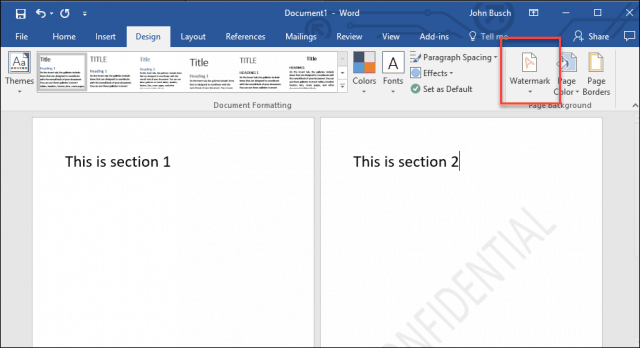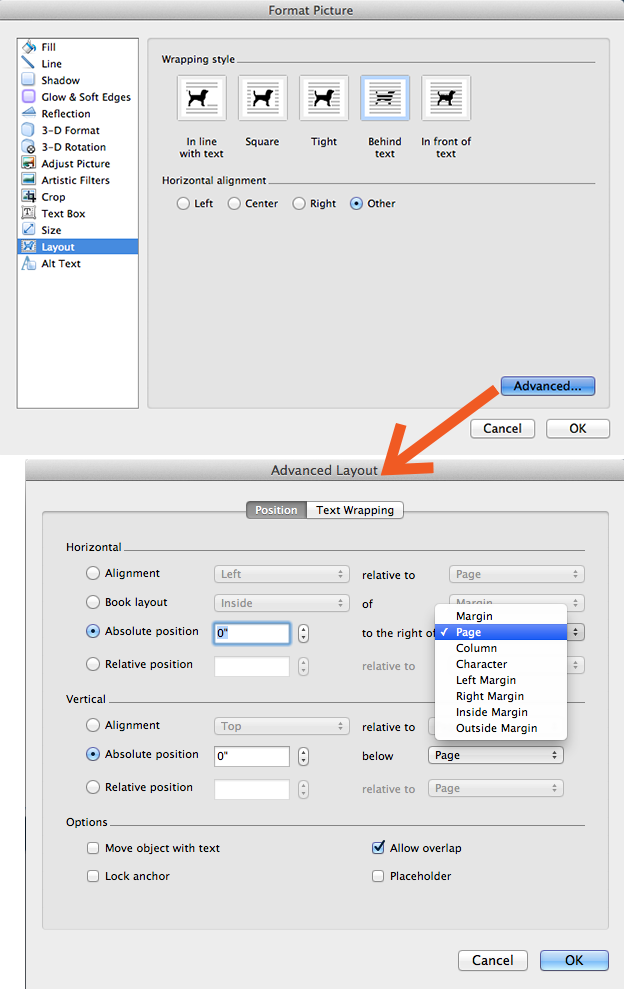- Fill Effects For Whole Page In Word Mac 2016 Version
- Fill Effects For Whole Page In Word Mac 2016 Free
- Fill Effects In Word Mac
How many times have you opened Microsoft Word only to be met with the ominous start screen? Showing numerous templates, the start screen is undoubtedly helpful. However, it can get bothersome at times when you just want to get started quickly. Especially, if you're someone who uses Word only for writing purposes and happy with the standard blank template.
To add a texture to your document background, switch over to the “Design” tab on Word’s Ribbon, and then click the “Page Color” button. In the dropdown menu, click the “Fill Effects” option. In the Fill Effects window, switch to the “Texture” tab, pick a texture, and then click the “OK” button. To add a gradient, texture, pattern, or picture, select Fill Effects, and then go to Gradient, Texture, Pattern, or Picture and select an option. Patterns and textures are repeated (or “tiled”) to fill the entire page. To learn to set a Transparency value for your shape in PowerPoint 2016 for Mac, follow these steps: Select the shape that has a solid color, gradient, pictures or texture fill. Right-click (or Ctrl + click) the shape to bring up the contextual menu that you can see in Figure 2.
So, it got me thinking about the ways to skip the start screen and land directly on a blank document, thereby saving some precious time. And it seems it doesn't need much work since Microsoft includes an option to get Word to open a blank document directly by skipping the start screen.
Let's see how to get this done.
Psst ... this post also contains plenty of cool Word tricks to improve your productivity. So read till the end.
Disable Start Screen in Word


Step 1: Launch Word and click on the Blank Document option (trust me, this is the last time you'll be doing it). Now, click on File and select Options from the menu on the left side.
Step 2: Under the General category, scroll down to reach the Start up options. Now, uncheck the first and third option as shown in the image below, and that's it!
From now on, whenever you launch Word, you will be greeted by a new blank document instantly instead of a start screen.
Disable Start Screen in Excel and PowerPoint
Thankfully, Microsoft has kept similar settings for Excel and PowerPoint as well. All you have to do is open a blank sheet (or slide), go to the Options and disable the Start up options.
Also on Guiding Tech
How to Make a Watermark in Microsoft Word
Read MoreAdditional Word 2016 Tips & Tricks
1. Crop Images to a Specific Shape

Yep, you read that right. With Word 2016, cropping an image in Word isn't limited to a square or a rectangular form, you can try out different shapes. This feature is most helpful when you want to reshape photos for a funky presentation.
All you have to do is select the picture and click on Crop. Choose Aspect ratio as 1:1, though it's not a mandatory step. Once done, select the Crop to shape option and pick a shape from the library. Drag the handle as your image demands and that's about it.
2. Change Default Save Locations
Another cool trick is to change the default location to save the documents. As you may already know, files are saved in the My Documents folder of your PC by default.
If you like to keep your documents organized, I'd recommend setting a custom folder's path as the Save location.
To change the default save location in Word, head over to Options and select the Save option. Enter the new path under 'Default local file location' and hit OK.
Next time you save a file locally, click on the Browse icon and your selected location will show up instantly. Also, you can pin the location by clicking on the Pin location icon on the right pane.
3. Calculations in Word
Did you know that Word has a handy calculator feature which lets you calculate simple equations? However, this command is disabled by default and is placed deep inside the settings.
Once enabled, all you have to do is select the equations and the results will be displayed on the status bar. To enable it, click on File >Options > Quick Access Toolbar and select All Commands from the drop-down list under Choose commands.
From the list, select Calculate and click on Add.
Hitting the OK button will add the Calculate command to the toolbar. To test it, just write a simple equation, select it (without selecting the = sign) and hit the Calculate icon near the Quick Access toolbar.
The results will be displayed on the status bar. Nifty, right?
4. Change the Default Font
Don't like the default font and its size in Word? You can change it. To make this adjustment, go to the Home tab and click on the Arrow icon at the bottom-right corner to expand the Font section. Alternatively, you can use the Ctrl+D keyboard shortcut.
Select the new font and size from the Font window. Now, click on the Set as default button and select 'All documents based on the Normal template' option from the pop-up window.
Once you do that, every document you open will have the new font.
Note: This change will only affect all the documents you create using the Normal template.Also on Guiding Tech
Top 9 Productive Add-ins for Word on iOS (iPad)
Read MoreGet The Most Out of Word
So this is how you can skip the default Start Screen of MS Word and head straight to a blank document. Also, with the font and size of your choice, all you need to do is launch Word to get started right away. No need to waste a couple of seconds over the start screen.
 The above article may contain affiliate links which help support Guiding Tech. However, it does not affect our editorial integrity. The content remains unbiased and authentic.Read NextHow to Get Transparent Start Menu in Windows 10
The above article may contain affiliate links which help support Guiding Tech. However, it does not affect our editorial integrity. The content remains unbiased and authentic.Read NextHow to Get Transparent Start Menu in Windows 10 Also See#productivity #Office #word
Also See#productivity #Office #word Did You Know
Notion was founded by Ivan Zhao.
Fill Effects For Whole Page In Word Mac 2016 Version
More in Windows
Top 4 Tools to Extract RAR Files in Windows 10
Would you like to create a questionnaire, sign-up form, quiz or other type of form that people can fill out on their computer? If so, here are some general instructions on how to create a form using Microsoft Word 2011 or Word 2016 on your Mac. Once you’ve created the form you can distribute it as an email attachment or via a web site. The recipient could then complete the form on his or her computer and return it to you. Here are some pointers to how to create a form using Word 2011 and 2016
By default Word’s Form Control features are hidden. To make them visible you have to enable the Developer tab on the Ribbon. Here’s how to do this:
- Open a new document in Word.
- Click on the Word menu and select Preferences.
- Click the Ribbon button on the bottom row on the right-hand side.
- In the Customize section, scroll through the list and insert a check mark next to Developer.
- Click the OK button.
- Click on the Developer tab on the Ribbon and you’ll see the Form Controls as depicted below.
You can now use these controls in a document. Let’s look at how to use the Text Box, Combo Box and Check Box.
The Text Box lets the form-filler type in their own answer. Click the Text Box option to insert a Text Box into your Word document. Double-click on this Text Box to control its options. For example, you could set a Maximum Length for the recipient’s answer.
The Check Box lets you create a box that can be checked by the form-filler.
Fill Effects For Whole Page In Word Mac 2016 Free
The Combo Box lets you enter a list of choices that will appear in a drop-down list. The form-filler can select only one choice. After adding a Combo Box to your Word document, double-click it to be able to enter the choices that you want to offer.
The Protect Form button is very important. After you’ve finished your document click the Protect Form button. This button locks the document so it can’t be edited. In other words, it turns the document into a fillable form. Once you’ve protected the form you’re ready to distribute it to others.
Fill Effects In Word Mac
Below is a picture of a sample document which demonstrates the Text Box, Combo Box and Check Box.